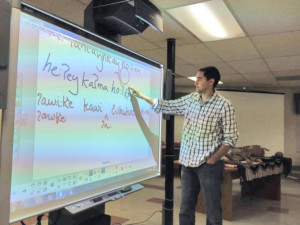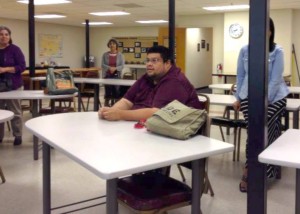Southern Pomo Project
 For a more detailed description of our fragmented languages scale, click here.
For a more detailed description of our fragmented languages scale, click here.
Southern Pomo is one of seven mutually unintelligible Pomoan languages which are native to the Clear Lake and Russian River areas of Northern California. Southern Pomo was spoken from Sebastopol (baṭʰ:inkʰleʔčawi ‘at house of elderberry trees’) in the south to Cloverdale (ma:kʰahmo ‘salmon-hole’) in the north. Southern Pomo speakers suffered almost complete genocide at the hands of Spanish, Mexican, and American governments. Those speakers who survived the violence lived to see their children taken away to boarding schools where they were forced to use English.
At the beginning of the nineteenth century–before contact with Spanish or English–the language had a few thousand speakers, but by the beginning of the twentieth century the language had fewer than one hundred speakers. By the beginning of the twenty-first century there were two known fluent speakers, one of whom has recently passed away.
Three linguists have worked significantly on the language. Abraham Halpern worked on the Cloverdale dialect of Southern Pomo in the late 1930s and early 1940s. His data came from Annie Burke, who lived outside of the historic Southern Pomo area and could speak the Central Pomo of her in-laws in addition to her mother tongue. Halpern later worked with Burke’s daughter, Elsie Allen, in the 1980s. Robert L. Oswalt, who wrote a grammar of the neighboring Kashaya Pomo language, also worked extensively with Southern Pomo throughout the latter half of the twentieth century. He also worked with Elsie Allen, Halpern’s Cloverdale-dialect-speaking consultant, and he collected the best material on the Dry Creek dialect from Elizabeth Dollar. Neil Alexander Walker began studying Southern Pomo in 2000 after meeting the last fluent speaker in the Dry Creek Rancheria Band of Pomo Indians, who was his wife’s paternal great aunt. Walker was able to meet with Oswalt during the last three years of Oswalt’s life and eventually wrote the first grammar of Southern Pomo. (You can view an updated version of Walker’s grammar here).
From October of 2011 to March of 2014 Walker taught Southern Pomo in weekly classes held by the Dry Creek Rancheria Band of Pomo Indians. In April of 2014 these classes stopped and were restarted by WIELD. The California Indian Museum and Cultural Center generously allowed WIELD to use their large conference space to hold Southern Pomo classes till the end of the term.
This website will eventually host a variety of language-learning materials for Southern Pomo students. There will also be some password-protected areas for more sensitive materials. If you are a member of a Southern Pomo heritage community and feel you should have permission to access password-protected materials, please inform us via the contact us option on the menu.
Below is a sample handout from the most recent round of Southern Pomo classes:
Click here for a draft of a textual dictionary of Southern Pomo.
Click here for a PC keyboard for the alphabet used to write Southern Pomo.
Photos from the Southern Pomo classes taught at the CIMCC:


